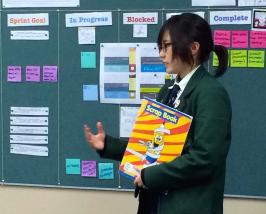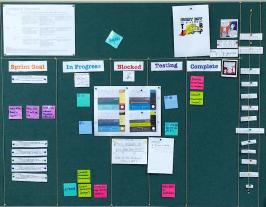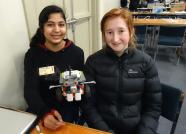Strategies for engaging girls in computer science
Teaching inquiry
How can I ensure that the girls at Columba College see computer science as engaging and offering viable career paths for women?
Introduction
Mechatronic engineering, computer science and Chinese, and studying computer science and physics at Princeton are the aspirations of some of the Columba College year 13 digital technologies programme graduates. All students from the class intend following a digital pathway, often in combination with another degree. For example, one student who produced an online comic plans to do a fine arts degree in combination with computer science.
Julie McMahon (HOF, Technology) has worked out a successful approach to digital technologies learning that has girls fascinated by computer science. The students are seeing it as the foundation of multiple career paths in the twenty-first century.
Julie discusses her approach to software engineering. She also writes about the importance of contextualising computer science to engage girls in this assignment submitted for a paper at Canterbury University.
Software Engineering: Contextualising Computer Science (PDF, 9 MB)
The girls presented at the Computer Science for High Schools (CS4HS) conference in Christchurch. Their presentation is available on YouTube: CS4HS CHCH Student talk.
Key factors
Two key factors were:
- ensuring that classroom practice reflects current industry thinking in computer science
- allowing the girls to work in a collegial fashion.
The “word on the street” at the school is that digital technologies is an innovative and “onto it” course. In addition, the collegiality of the scrum methodology contradicts the perception often held by girls that computer science is for “geeky” programmers working in isolation.

Scrum methodology
Scrum is a project management framework used in software engineering. Teams work together on problem solving and decision making to ensure a quality product is produced in a timely manner. The approach includes stand-up meetings where team members meet each day. In these meetings the work for the day and progress to date is discussed. The group raises any problems that could impede progress. Each project has a scrum board and post-it notes are used to record progress.
Julie introduced this system to the students. The students found it an extremely effective way to not only manage their projects. They also found it provided evidence for curriculum level 8 understandings of project management, AS 91609 Undertake project management to support technological practice, and the Scholarship standard.
Students each had their scrum boards around the room for their project. They indicated what stage they were at with laminated post-its, using the categories of Scrum methodology – sprint goal, in progress, blocked, testing, and complete. This allowed Julie to easily see where her guidance was needed. Students used stand-up meetings to share their project issues and were also able to indicate where they could assist each other to resolve issues.

Building confidence in project management and technological practice
The success of using this approach at level 3 is in part due to building confidence in project management and technological practice throughout their years in the digital technologies programme. Students acquire curriculum level 6 technological practice skills through a game development project in year 11.
In year 12 students extend their technological practice skills to curriculum level 7 through a project where they create a conceptual design for a website and then code the website in HTML and CSS. At level 8 of the curriculum students are then ready to step up and manage their own project of choice from beginning to end.
NCEA level 3 projects this year have included an online comic with parallax scrolling produced by a student who is a talented illustrator and a website for a local air cadet training group.
School culture supports computer science and technology
Julie also identifies supporting education beyond the classroom as another important strategy to lift the profile of digital technologies and the technology learning area.
Robotics club
A robotics club is run after school with students entering in the National Robocup Competition. The girls have found the Theatre Challenge particularly engaging. They came up with a presentation using robots based on the Wizard of Oz (Columba’s school production that year). Sandy Garner, a lecturer in computer science at Otago University assists with the robotics club.
Showcasing student success
Student success in digital technologies is also celebrated through the school website. The students recent success in the Robocup competition was described in the Columba newsletter.
Technology Prefect
This is the first year the school has had a technology prefect. One of the students suggested at the end of her year 12 that the school could do with a technology prefect. After hearing her convincing speech, both Julie and the principal couldn’t help but agree and she was duly appointed!
Coding clubs
Year 13 students also mentor a coding club run after school for years 9 and 10. There are plans to start a code club for years 7 and 8 to introduce these younger students to the concepts of coding. Julie notes that there are some very good resources available free at code club.

